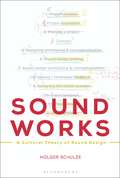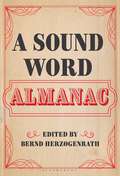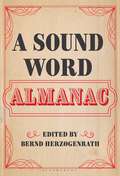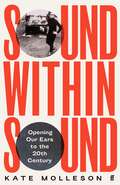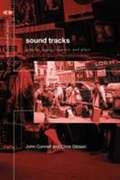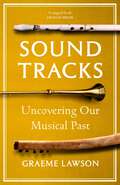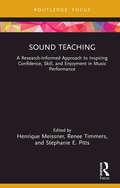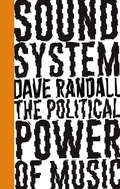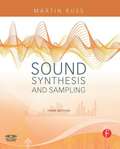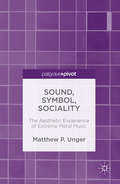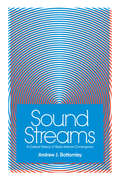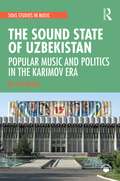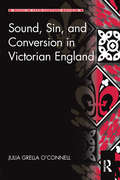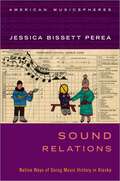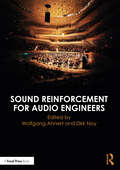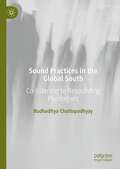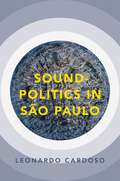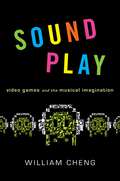- Table View
- List View
Sound Works: A Cultural Theory of Sound Design
by Holger SchulzeWhat is sound design? What is its function in the early 21st century and into the future?Sound Works examines these questions in four parts: Part 1, "Why This Sound?", presents an overview of the modern history of sound design. Part 2 is highly visual and provides a glance onto a sound designer's workbench and the current state of "Sonic Labor." Part 3 uses cultural analysis to explore our contemporary "Living with Sounds." The final and fourth part then proposes a series of anthropological and political interpretations of how “Sound Works” today. This book is not a manual on sound design; it instead argues for a cultural theory of sound design for sound designers and sound artists, for clients who commission a sound design and for researchers in the fields of sound studies, design research, and cultural studies
A Sound Word Almanac
by Bernd HerzogenrathThis almanac of sound words important to artists and scholars highlights words that expand the way we speak (and write) about sonic experiences.Why write about sound, and how? If sonic philosophy is the attempt "to think about sound by philosophical means," then a metaphilosophical debate appears almost immediately on the horizon: What is called for is an understanding about sound and language, but also about the preconditions of musical understanding. What is at stake is the question of language and sound, as well as expanding how we speak about sonic experience.This almanac tackles these questions from artistic, experimental and personal perspectives. An assemblage of nearly 70 practitioners and theoreticians, artists and scholars offer their favorite 'sound word.' These sound words are onomatopoetical, mythological, practical; words of personal importance to the artists and their craft; words from their memory, related to sound. Many entries are not in English – some are untranslatable – and all are accompanied by a personal, explanatory, poetic entry. These are words that have the potential to change our perspective on listening-musicking-thinking.
A Sound Word Almanac
This almanac of sound words important to artists and scholars highlights words that expand the way we speak (and write) about sonic experiences.Why write about sound, and how? If sonic philosophy is the attempt "to think about sound by philosophical means," then a metaphilosophical debate appears almost immediately on the horizon: What is called for is an understanding about sound and language, but also about the preconditions of musical understanding. What is at stake is the question of language and sound, as well as expanding how we speak about sonic experience.This almanac tackles these questions from artistic, experimental and personal perspectives. An assemblage of nearly 70 practitioners and theoreticians, artists and scholars offer their favorite 'sound word.' These sound words are onomatopoetical, mythological, practical; words of personal importance to the artists and their craft; words from their memory, related to sound. Many entries are not in English – some are untranslatable – and all are accompanied by a personal, explanatory, poetic entry. These are words that have the potential to change our perspective on listening-musicking-thinking.
Sound Within Sound: Opening Our Ears to the Twentieth Century
by Kate MollesonA radical new book by journalist, critic and BBC Radio 3 broadcaster Kate Molleson, which fundamentally changes the way we think about classical music and the musicians who made it on a global scale.'Wonderful . . . This is a book of discovery that speaks of music as a life force, that urges us to live our lives through music. 'COSEY FANNI TUTTI'A marvellous book that opens our ears to sonic worlds that will enrich and delight us, whoever and wherever we are.'IAN McMILLAN'A clear-eyed, utterly fascinating exploration of outsiders in classical music. Molleson's excellent book challenges and enlightens.'SINÉAD GLEESONThis is the impassioned and exhilarating story of the composers who dared to challenge the conventional world of classical music in the twentieth century.Traversing the globe from Ethiopia and the Philippines to Mexico, Jerusalem, Russia and beyond, journalist, critic and BBC Radio 3 broadcaster Kate Molleson tells the stories of ten figures who altered the course of musical history, only to be sidelined and denied recognition during an era that systemically favoured certain sounds - and people - over others.A celebration of radical creativity rooted in ideas of protest, gender, race, ecology and resistance, Sound Within Sound is an energetic reappraisal of twentieth-century classical music that opens up the world far beyond its established centres, challenges stereotypical portrayals of the genre and shatters its traditional canon.'Sound Within Sound is absolutely inspiring. Everyone who loves music should own this book.'CHARLOTTE HIGGINS'A necessary and deeply humane reshaping of music histories. It undoes the narrowing constraints of the classical canon, leaving the culture - and the reader - beautifully enriched.'EMMA WARREN'Marvellous . . . required reading.'THE WIRE
Sound Tracks: Popular Music Identity and Place (PDF)
by John ConnellSound Tracks is the first comprehensive book on the new geography of popular music, examining the complex links between places, music and cultural identities. It provides an interdisciplinary perspective on local, national and global scenes, from the 'Mersey' and 'Icelandic' sounds to 'world music', and explores the diverse meanings of music in a range of regional contexts.
Sound Tracks: Uncovering Our Musical Past
by Graeme LawsonA transporting voyage of archaeological discovery: Sound Tracks unearths instruments from around the world and across time, releasing the past's musical secrets for the first time. ‘A thrilling journey into the sonic richness of human experience’ PHILIP BALL, author of The Music Instinct‘A magical book’ FRANCIS PRYOR, author of Britain BCFrom the present day back to the dawn of time, from dark caves and murky swamps to open deserts and ocean depths, here is the history of humankind's relationship with music in fifty detective stories.We see a child’s delight in Peru in AD 700, playing with a water-filled pot that chirps like a bird; we shiver with a lonely soldier sending trumpet signals to the next watchtower on Hadrian's Wall; we sway to the stately rhythms of the 64 bells buried in a tomb in China in the 5th century BC. And on this grand tour, we learn that music is part of what makes us human – a way of commemorating our pasts, communicating with others and shaping our lives.Brimming with astonishing insights, Sound Tracks provides an enthralling alternative history of humanity in which the silences of the past are filled with a glorious treasure hoard of vanished sounds and voices.‘Piles revelation upon revelation to shed a completely new perspective on the tools we use for making music’ NORMAN LEBRECHT, author of Why Beethoven‘Lawson has brilliantly conjured up the sounds of 30,000 years of human history’ DAVID ABULAFIA, Professor Emeritus of Mediterranean History
Sound Teaching: A Research-Informed Approach to Inspiring Confidence, Skill, and Enjoyment in Music Performance
by Henrique Meissner Renee Timmers Stephanie E. PittsSound Teaching explores the ways in which music psychology and education can meet to inspire developments in the teaching and learning of music performance. The book is based on music practitioners’ research into aspects of their own professional practice. Each chapter addresses a specific topic related to musical communication and expression, performance confidence and enjoyment, or skill development in individual and group learning. It explains the background of the research, outlines main findings, and provides suggestions for practical applications. Sound Teaching provides a research-informed approach to teaching and contributes to music tutors’ professional development in teaching children and adults of various ages and abilities. Sound Teaching is written for vocal and instrumental music teachers, music performers with a portfolio career, and music students at conservatoires and universities. Music students undertaking practice-related research will find examples of research methodologies and projects that are informative for their studies. Musical participants of all kinds – students, teachers, performers, and audiences – will find new ways of understanding their practice and experience through research.
Sound Teaching: A Research-Informed Approach to Inspiring Confidence, Skill, and Enjoyment in Music Performance
by Henrique Meissner Renee Timmers Stephanie E. PittsSound Teaching explores the ways in which music psychology and education can meet to inspire developments in the teaching and learning of music performance. The book is based on music practitioners’ research into aspects of their own professional practice. Each chapter addresses a specific topic related to musical communication and expression, performance confidence and enjoyment, or skill development in individual and group learning. It explains the background of the research, outlines main findings, and provides suggestions for practical applications. Sound Teaching provides a research-informed approach to teaching and contributes to music tutors’ professional development in teaching children and adults of various ages and abilities. Sound Teaching is written for vocal and instrumental music teachers, music performers with a portfolio career, and music students at conservatoires and universities. Music students undertaking practice-related research will find examples of research methodologies and projects that are informative for their studies. Musical participants of all kinds – students, teachers, performers, and audiences – will find new ways of understanding their practice and experience through research.
Sound System: The Political Power of Music (Left Book Club)
by Dave RandallMusicians have often wanted to change the world. From underground innovators to pop icons many have believed in the political power of music. Rulers recognise it too. Music has been used to challenge the political and social order - and to prop up the status quo.*BR**BR*Sound System is the story of one musician's journey to discover what makes music so powerful. Dave Randall uses his insider's knowledge of the industry to shed light on the secrets of celebrity, commodification and culture.*BR**BR*This is a book of raves, riots and revolution. From the Glastonbury Festival to the Arab Spring, Pop Idol to Trinidadian Carnival, Randall finds political inspiration across the musical spectrum and poses the question: how can we make music serve the interests of the many, rather than the few? *BR**BR*Published in partnership with the Left Book Club.
Sound System: The Political Power of Music (Left Book Club)
by Dave RandallMusicians have often wanted to change the world. From underground innovators to pop icons many have believed in the political power of music. Rulers recognise it too. Music has been used to challenge the political and social order - and to prop up the status quo.*BR**BR*Sound System is the story of one musician's journey to discover what makes music so powerful. Dave Randall uses his insider's knowledge of the industry to shed light on the secrets of celebrity, commodification and culture.*BR**BR*This is a book of raves, riots and revolution. From the Glastonbury Festival to the Arab Spring, Pop Idol to Trinidadian Carnival, Randall finds political inspiration across the musical spectrum and poses the question: how can we make music serve the interests of the many, rather than the few? *BR**BR*Published in partnership with the Left Book Club.
Sound Synthesis And Sampling
by Martin RussSound Synthesis and Sampling' provides a comprehensive introduction to the underlying principles and practical techniques applied to both commercial and research sound synthesizers. This new edition has been updated throughout to reflect current needs and practices- revised and placed in a modern context, providing a guide to the theory of sound and sampling in the context of software and hardware that enables sound making. For the revised edition emphasis is on expanding explanations of software and computers, new sections include techniques for making sound physically, sections within analog and digital electronics. Martin Russ is well known and the book praised for its highly readable and non-mathematical approach making the subject accessible to readers starting out on computer music courses or those working in a studio.
Sound, Symbol, Sociality: The Aesthetic Experience of Extreme Metal Music
by Matthew UngerBased on ethnographic research within the extreme metal community, Unger offers a thought-provoking look at how symbols of authenticity and defilement fashion social experience in surprising ways. Exploring the many themes and ciphers that comprise this musical community, this book interprets aesthetic resonances as a way to understand contemporary identity, politics, and social relations. In the end, this book develops a unique argument: the internal composition of the community’s music and sound moulds symbols that shape, reflect, and constrain social patterns of identity, difference, and transgression. This book contributes to the sociology of sound and music, the study of religion in popular culture, and the role of aesthetics in everyday life. It will be of interest to upper level students, post-graduate students and scholars of religion, popular culture, and philosophy.
Sound Streams: A Cultural History of Radio-Internet Convergence
by Andrew J BottomleyIn talking about contemporary media, we often use a language of newness, applying words like “revolution” and “disruption.” Yet, the emergence of new sound media technologies and content—from the earliest internet radio broadcasts to the development of algorithmic music services and the origins of podcasting—are not a disruption, but a continuation of the century-long history of radio. Today’s most innovative media makers are reintroducing forms of audio storytelling from radio’s past. Sound Streams is the first book to historicize radio-internet convergence from the early ’90s through the present, demonstrating how so-called new media represent an evolutionary shift that is nevertheless historically consistent with earlier modes of broadcasting. Various iterations of internet radio, from streaming audio to podcasting, are all new radio practices rather than each being a separate new medium: radio is any sound media that is purposefully crafted to be heard by an audience. Rather than a particular set of technologies or textual conventions, web-based broadcasting combines unique practices and features and ideas from radio history. In addition, there exists a distinctive conversationality and reflexivity to radio talk, including a propensity for personal stories and emotional disclosure, that suits networked digital media culture. What media convergence has done is extend and intensify radio’s logics of connectivity and sharing; sonically mediated personal expression intended for public consideration abounds in online media networks. Sound Streams marks a significant contribution to digital media and internet studies. Its mix of cultural history, industry research, and genre and formal analysis, especially of contemporary audio storytelling, will appeal to media scholars, radio and podcast practitioners, audio journalism students, and dedicated podcast fans.
The Sound State of Uzbekistan: Popular Music and Politics in the Karimov Era (SOAS Studies in Music Series)
by Kerstin KlenkeThe Sound State of Uzbekistan: Popular Music and Politics in the Karimov Era is a pioneering study of the intersection between popular music and state politics in Central Asia. Based on 20 months of fieldwork and archival research in Tashkent, this book explores a remarkable era in Uzbekistan’s politics (2001–2016), when the Uzbek government promoted a rather unlikely candidate to the prominent position of state sound: estrada, a genre of popular music and a musical relic of socialism. The political importance it attached to estrada was matched by the establishment of an elaborate bureaucratic apparatus for state oversight. The Sound State of Uzbekistan shows the continuing legacy of Soviet concepts to frame the nexus between music, artists and the state, and explains the extraordinary potency ascribed to estrada. At the same time, it challenges classical readings of transition and also questions common binary models for researching culture in totalitarian or authoritarian states. Proposing to approach lives in music under authoritarianism as a form of normality instead, the author promotes a post-Cold War paradigm in music studies.
The Sound State of Uzbekistan: Popular Music and Politics in the Karimov Era (SOAS Studies in Music Series)
by Kerstin KlenkeThe Sound State of Uzbekistan: Popular Music and Politics in the Karimov Era is a pioneering study of the intersection between popular music and state politics in Central Asia. Based on 20 months of fieldwork and archival research in Tashkent, this book explores a remarkable era in Uzbekistan’s politics (2001–2016), when the Uzbek government promoted a rather unlikely candidate to the prominent position of state sound: estrada, a genre of popular music and a musical relic of socialism. The political importance it attached to estrada was matched by the establishment of an elaborate bureaucratic apparatus for state oversight. The Sound State of Uzbekistan shows the continuing legacy of Soviet concepts to frame the nexus between music, artists and the state, and explains the extraordinary potency ascribed to estrada. At the same time, it challenges classical readings of transition and also questions common binary models for researching culture in totalitarian or authoritarian states. Proposing to approach lives in music under authoritarianism as a form of normality instead, the author promotes a post-Cold War paradigm in music studies.
Sound, Sin, and Conversion in Victorian England (Music in Nineteenth-Century Britain)
by Julia Grella O'ConnellThe plight of the fallen woman is one of the salient themes of nineteenth-century art and literature; indeed, the ubiquity of the trope galvanized the Victorian conscience and acted as a spur to social reform. In some notable examples, Julia Grella O’Connell argues, the iconography of the Victorian fallen woman was associated with music, reviving an ancient tradition conflating the practice of music with sin and the abandonment of music with holiness. The prominence of music symbolism in the socially-committed, quasi-religious paintings of the Pre-Raphaelites and their circle, and in the Catholic-Wagnerian novels of George Moore, gives evidence of the survival of a pictorial language linking music with sin and conversion, and shows, even more remarkably, that this language translated fairly easily into the cultural lexicon of Victorian Britain. Drawing upon music iconography, art history, patristic theology, and sensory theory, Grella O’Connell investigates female fallenness and its implications against the backdrop of the social and religious turbulence of the mid-nineteenth century.
Sound, Sin, and Conversion in Victorian England (Music in Nineteenth-Century Britain)
by Julia Grella O'ConnellThe plight of the fallen woman is one of the salient themes of nineteenth-century art and literature; indeed, the ubiquity of the trope galvanized the Victorian conscience and acted as a spur to social reform. In some notable examples, Julia Grella O’Connell argues, the iconography of the Victorian fallen woman was associated with music, reviving an ancient tradition conflating the practice of music with sin and the abandonment of music with holiness. The prominence of music symbolism in the socially-committed, quasi-religious paintings of the Pre-Raphaelites and their circle, and in the Catholic-Wagnerian novels of George Moore, gives evidence of the survival of a pictorial language linking music with sin and conversion, and shows, even more remarkably, that this language translated fairly easily into the cultural lexicon of Victorian Britain. Drawing upon music iconography, art history, patristic theology, and sensory theory, Grella O’Connell investigates female fallenness and its implications against the backdrop of the social and religious turbulence of the mid-nineteenth century.
Sound Relations: Native Ways of Doing Music History in Alaska (American Musicspheres)
by Jessica Bissett PereaSound Relations delves into histories of Inuit musical life in Alaska to register the significance of sound as integral to self-determination and sovereignty. Offering radical and relational ways of listening to Inuit performances across a range of genres--from hip hop to Christian hymnody and traditional drumsongs to funk and R&B --author Jessica Bissett Perea registers how a density (not difference) of Indigenous ways of musicking from a vast archive of presence sounds out entanglements between structures of Indigeneity and colonialism. This work dismantles stereotypical understandings of "Eskimos," "Indians," and "Natives" by addressing the following questions: What exactly is "Native" about Native music? What does it mean to sound (or not sound) Native? Who decides? And how can in-depth analyses of Native music that center Indigeneity reframe larger debates of race, power, and representation in twenty-first century American music historiography? Instead of proposing singular truths or facts, this book invites readers to consider the existence of multiple simultaneous truths, a density of truths, all of which are culturally constructed, performed, and in some cases politicized and policed. Native ways of doing music history engage processes of sound worlding that envision otherwise, beyond nation-state notions of containment and glorifications of Alaska as solely an extraction site for U.S. settler capitalism, and instead amplifies possibilities for more just and equitable futures.
Sound Relations: Native Ways of Doing Music History in Alaska (American Musicspheres)
by Jessica Bissett PereaSound Relations delves into histories of Inuit musical life in Alaska to register the significance of sound as integral to self-determination and sovereignty. Offering radical and relational ways of listening to Inuit performances across a range of genres--from hip hop to Christian hymnody and traditional drumsongs to funk and R&B --author Jessica Bissett Perea registers how a density (not difference) of Indigenous ways of musicking from a vast archive of presence sounds out entanglements between structures of Indigeneity and colonialism. This work dismantles stereotypical understandings of "Eskimos," "Indians," and "Natives" by addressing the following questions: What exactly is "Native" about Native music? What does it mean to sound (or not sound) Native? Who decides? And how can in-depth analyses of Native music that center Indigeneity reframe larger debates of race, power, and representation in twenty-first century American music historiography? Instead of proposing singular truths or facts, this book invites readers to consider the existence of multiple simultaneous truths, a density of truths, all of which are culturally constructed, performed, and in some cases politicized and policed. Native ways of doing music history engage processes of sound worlding that envision otherwise, beyond nation-state notions of containment and glorifications of Alaska as solely an extraction site for U.S. settler capitalism, and instead amplifies possibilities for more just and equitable futures.
Sound Reinforcement for Audio Engineers
by Wolfgang AhnertSound Reinforcement for Audio Engineers illustrates the current state of the art in sound reinforcement. Beginning with an outline of various fields of applications, from sports venues to religious venues, corporate environments and cinemas, this book is split into 11 chapters covering room acoustics, loudspeakers, microphones and acoustic modelling among many other topics. This comprehensive book packed with references and a historical overview of sound reinforcement design is an essential reference book for students of acoustics and electrical engineering, but also for engineers looking to expand their knowledge of designing sound reinforcement systems.
Sound Reinforcement for Audio Engineers
by Wolfgang Ahnert Dirk NoySound Reinforcement for Audio Engineers illustrates the current state of the art in sound reinforcement. Beginning with an outline of various fields of applications, from sports venues to religious venues, corporate environments and cinemas, this book is split into 11 chapters covering room acoustics, loudspeakers, microphones and acoustic modelling among many other topics. This comprehensive book packed with references and a historical overview of sound reinforcement design is an essential reference book for students of acoustics and electrical engineering, but also for engineers looking to expand their knowledge of designing sound reinforcement systems.
Sound Practices in the Global South: Co-listening to Resounding Plurilogues
by Budhaditya ChattopadhyayThis book develops a comprehensive understanding of the unique sound worlds of key regions in the Global South, through an auto-ethnographic method of self-reflective conversations with prominent sound practitioners from South Asia, Africa, the Middle East and Latin America. The conversations navigate various trajectories of sound practices, illuminating intricate sonic processes of listening, thinking through sounds, ideating, exposing, and performing with sound. This collection of conversations constitutes the main body of the book, including critical and scholarly commentaries on aural cultures, sound theory and production. The book builds a ground-up approach to nurturing knowledge about aural cultures and sonic aesthetics, moving beyond the Eurocentric focus of contemporary sound studies. Instead of understanding sound practices through consumption and entertainment, they are explored as complex cultural and aesthetic systems, working directly with the practitioners themselves, who largely contribute to the development of the sonic methodologies. Refocusing on the working methods of practitioners, the book reveals a tension between the West’s predominant colonial-consumerist cultures, and the collective desires of practitioners to resist colonial models of listening by expressing themselves in terms of their arts and craft, and their critical faculties.Conversations with: Clarence Barlow, Sandeep Bhagwati, Rajesh K. Mehta, Sharif Sehnaoui, Ximena Alarcón Díaz, Hardi Kurda, Mario de Vega, Luka Mukhavele, Khyam Allami, Cedrik Fermont, Khaled Kaddal, David Velez, Juan Duarte, Youmna Saba, Abdellah M. Hassak, Mariana Marcassa, Amanda Gutiérrez, Syma Tariq, Alma Laprida, Siamak Anvari, Mohamad Safa, Debashis Sinha, Zouheir Atbane, Constanza Bizraelli, Jatin Vidyarthi, Joseph Kamaru, Surabhi Saraf, Isuru Kumarasinghe, Hemant Sreekumar.
SOUND-POLITICS IN SAO PAULO CILAM C (Currents in Latin American and Iberian Music)
by Leonardo CardosoHow does the state separate music from noise? How can such a filtering apparatus shape the content and form of sound production in the city? As a marker of co-presence to the hearing body, sound is always open to (or rather opens up) the politics of shared existence. In the throes of the post-dictatorship period, Brazil's legislative and executive branches implemented a series of sweeping measures to address quality of life concerns, including environmental pollution and urban inequality. In São Paulo, noise control became a recurrent controversy, growing in size and scale between the 1990s and 2010s. Together with the much-debated fear of crime and the socioeconomic and cultural tensions between the rich urban center and the poor peripheries, such ecological agendas against noise as a harmful pollutant have reconfigured the presence of environmental sounds in the city. In this book, Cardoso argues that the framing of specific sounds as unavoidable, unnecessary, or as harmful "noise" has been an effective strategy to organize spaces and administer group behavior in this rapidly expanding city. He focuses on two interrelated processes. First, the series of institutional regulatory mechanisms that turn sounds into the all-embracing "noise" susceptible to state intervention. Second, the constant attempts of interested groups in either attaching or detaching specific sounds (musical events, industrial noise, traffic noise, religious sounds, etc.) from regulatory scrutiny. Sound-politics is the dynamic that emerges from both processes - the channels through which sounds enter (and leave) the sphere of state regulation.
Sound-Politics in São Paulo (Currents in Latin American and Iberian Music)
by Leonardo CardosoHow does the state separate music from noise? How can such a filtering apparatus shape the content and form of sound production in the city? As a marker of co-presence to the hearing body, sound is always open to (or rather opens up) the politics of shared existence. In the throes of the post-dictatorship period, Brazil's legislative and executive branches implemented a series of sweeping measures to address quality of life concerns, including environmental pollution and urban inequality. In São Paulo, noise control became a recurrent controversy, growing in size and scale between the 1990s and 2010s. Together with the much-debated fear of crime and the socioeconomic and cultural tensions between the rich urban center and the poor peripheries, such ecological agendas against noise as a harmful pollutant have reconfigured the presence of environmental sounds in the city. In this book, Cardoso argues that the framing of specific sounds as unavoidable, unnecessary, or as harmful "noise" has been an effective strategy to organize spaces and administer group behavior in this rapidly expanding city. He focuses on two interrelated processes. First, the series of institutional regulatory mechanisms that turn sounds into the all-embracing "noise" susceptible to state intervention. Second, the constant attempts of interested groups in either attaching or detaching specific sounds (musical events, industrial noise, traffic noise, religious sounds, etc.) from regulatory scrutiny. Sound-politics is the dynamic that emerges from both processes - the channels through which sounds enter (and leave) the sphere of state regulation.
Sound Play: Video Games and the Musical Imagination (Oxford Music / Media)
by William ChengVideo games open portals to fantastical worlds where imaginative play and enchantment prevail. These virtual settings afford us considerable freedom to act out with relative impunity. Or do they? Sound Play explores the aesthetic, ethical, and sociopolitical stakes of people's creative engagements with gaming's audio phenomena-from sonorous violence to synthesized operas, from democratic music-making to vocal sexual harassment. William Cheng shows how video games empower their designers, composers, players, critics, and scholars to tinker (often transgressively) with practices and discourses of music, noise, speech, and silence. Faced with collisions between utopian and alarmist stereotypes of video games, Sound Play synthesizes insights across musicology, sociology, anthropology, communications, literary theory, philosophy, and additional disciplines. With case studies spanning Final Fantasy VI, Silent Hill, Fallout 3, The Lord of the Rings Online, and Team Fortress 2, this book insists that what we do in there-in the safe, sound spaces of games-can ultimately teach us a great deal about who we are and what we value (musically, culturally, humanly) out here. Foreword by Richard Leppert Video Games Live cover image printed with permission from Tommy Tallarico
